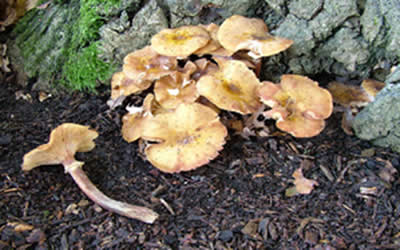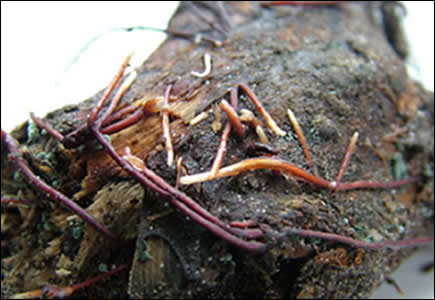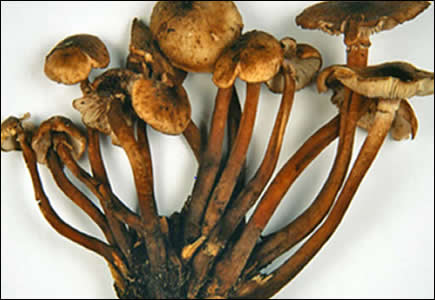HONEY FUNGUS
Honey fungus is the common name given to several different species of the fungus Armillaria that attack and kill the roots of many woody and perennial plants. The most characteristic symptom of honey fungus is white fungal growth between the bark and wood, usually at ground level. Clumps of honey coloured toadstools sometimes appear briefly on infected stumps in autumn.

Symptoms:
Decaying roots, white fungus between bark and wood, rhizomorphs, sudden death of plant. Caused by a fungus; mycelium and rhizomorphs are present all year, mushrooms only in late-summer to autumn. Honey fungus spreads underground, attacking and killing the roots and then decaying the dead wood. It is the most destructive fungal disease in UK gardens.
No plants are completely immune, but some few have very good resistance - Acer, Birch, Buddlea, Ceanothus, Cedrus, Cotoneaster, Fagus (beech), Hydrangea, Ilex (holly), Ligustrum (privet), Magnolia, Malus (apple), Prunus (except P. spinosus), Pyrus (pear), Quercus, Rhododendron (azalea), Salix (willow), Sorbus, Syringa (lilac) and Viburnum are all particularly susceptible to honey fungus.



To check whether a plant is infected, peel away the bark at the base and look for a white or creamy layer of fungal tissue.
Bootlace like growths can be seen protruding from the root. They will spread through the soil and if other plants are in the same pot they will soon be affected. Eventually toadstools will appear on the soil surface.

Control:
There are no chemicals available for control of honey fungus. If honey fungus is confirmed, the only effective remedy is destroy, by burning all the plant and the soil that it is in.